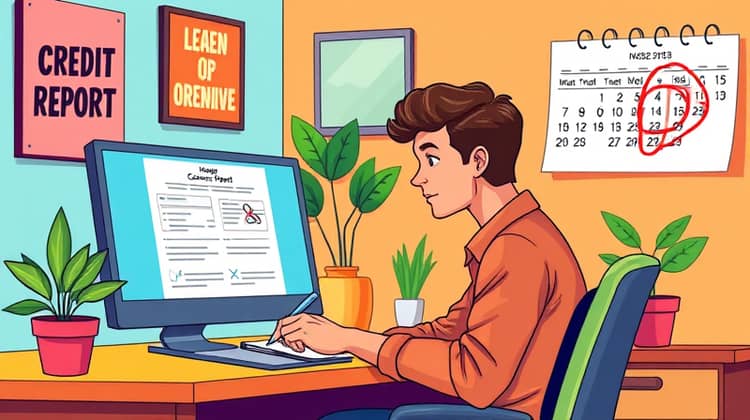Rebuilding Financial Life: 6 Ways to Secure a Loan Post-Bankruptcy

After declaring bankruptcy, many individuals find themselves wondering how they can rebuild their financial life and regain their borrowing capacity. Understanding that bankruptcy is a setback but not the end of your financial journey is crucial. While securing a loan post-bankruptcy may seem daunting, it is entirely possible with the right strategies.
In this article, we will discuss six effective methods for improving your chances of obtaining a loan despite your bankruptcy history. From assessing your current financial situation to exploring specialized lenders, these steps will guide you through the process of rebuilding your financial reputation and securing a loan that suits your needs.
By following these guidelines, you can pave the way for restoring your credit and achieving your financial goals. Let's dive into the strategies that will set you on the right path.
1. Understand Your Situation

The first step towards securing a loan post-bankruptcy is to understand your current financial state. This involves analyzing your debts, income, and living expenses to grasp where you stand financially. Knowing the specifics of your situation will help you tailor your loan application to your unique circumstances and demonstrate your awareness to potential lenders.
Furthermore, acknowledging your past mistakes and learning from them is essential. By reflecting on the reasons that led to your bankruptcy, you can avoid repeating these errors as you re-enter the lending market.
- Assess your current debts and prioritize them.
- Evaluate your monthly income and expenses to determine your budget for loan repayments.
- Identify areas where you can cut costs to increase your cash flow.
- Consider creating a plan that outlines how you will manage your finances moving forward.
- Set financial goals and timelines to stay on track and measure your progress.
Once you have a clear understanding of your financial situation, you can move on to the next steps in the process of securing a loan. This knowledge will empower you to present yourself more favorably to lenders and make informed financial decisions.
Being prepared with relevant financial data will also help you negotiate terms that align with your capabilities and needs.
2. Check Your Credit Report

Before applying for a loan, it's essential to review your credit report. After bankruptcy, your credit report will reflect this status, and it's important to know how it is impacting your ability to borrow. You can access a free credit report from the three major credit bureaus and identify any inaccuracies or issues that may need resolving.
Additionally, understanding your credit score is equally vital. Lenders use this score to evaluate the risk of lending to you, and being aware of your score can help you develop strategies for improvement. By knowing where you stand, you can better prepare for discussions with potential lenders.
- Request your credit report from each of the major credit bureaus: Equifax, Experian, and TransUnion.
- Review the report for errors or inaccuracies, and dispute any incorrect information that could negatively affect your score.
- Look for opportunities to improve your credit score, such as paying off outstanding debts.
- Note any derogatory marks, like late payments or accounts in collections, that are affecting your credit score.
- Regularly monitor your credit to ensure that you are staying on top of any changes.
Understanding your credit report will give you the framework necessary to make educated decisions about financing options. It is a vital tool for identifying where improvements can be made and how lenders will view your profile moving forward.
3. Improve Your Credit Score

Improving your credit score after bankruptcy may take time, but adopting proactive measures can significantly enhance your chances of securing a loan. Even minor improvements can have a considerable impact on your credibility with lenders, increasing your options.
Focus on adopting healthy financial habits, which will gradually reflect on your credit score and present a better picture to lenders.
- Pay bills on time to establish a consistent payment history.
- Reduce credit card balances and keep them low to improve your credit utilization ratio.
- Consider obtaining a secured credit card to build positive credit history over time.
- Limit the number of new credit inquiries to avoid unnecessary hits to your score.
- Stay informed about changes in your credit score and credit report status.
Focusing on rebuilding your credit score not only helps you secure a loan but also ensures better long-term interest rates and terms. The more you improve your score, the more lenders will be willing to work with you.
4. Consider a Secured Loan

One of the most practical options for obtaining a loan post-bankruptcy is to consider a secured loan. These loans are backed by an asset, which means that lenders have lower risk and are more likely to approve your application.
Secured loans can also come with lower interest rates and more favorable terms as compared to unsecured loans. However, it’s crucial to evaluate the risks, as your collateral could be at stake if you fail to repay the loan.
When deciding on a secured loan, make sure you have a solid repayment plan in place to avoid losing your valuable assets.
- Identify a valuable asset to use as collateral, such as a vehicle or savings account.
- Research lenders who offer secured loans and compare their terms and interest rates.
- Prepare necessary documentation, including proof of income and the value of the collateral.
- Apply for the secured loan keeping in mind the terms you can afford to meet.
- Maintain open communication with your lender throughout the process.
Secured loans can be an excellent way to get back on your feet financially. However, make sure you weigh all options and understand the commitment involved in securing one.
5. Look for a Co-Signer

Having a co-signer can significantly enhance your chances of securing a loan post-bankruptcy. A co-signer with a solid credit history can provide the lender with an additional assurance that the loan will be repaid, making them more likely to approve your application.
It’s essential to remember that a co-signer is legally responsible for the loan, meaning that if you fail to repay, their credit is impacted as well. Hence, choosing the right person as a co-signer is vital, and open discussions about expectations should take place.
- Choose someone with a strong credit history and financial stability.
- Discuss the terms of the loan with your co-signer to ensure they are comfortable with the responsibility.
- Provide clear timelines and payment responsibilities to maintain transparency and trust.
A co-signer can provide the boost needed to secure a loan, but it’s a decision that should be approached with caution and seriousness for both parties involved.
6. Explore Specialized Lenders

If traditional banks and lenders are unwilling to work with you due to your bankruptcy, consider exploring specialized lenders who focus on providing loans to individuals with low credit. These lenders understand the challenges posed by bankruptcy and may offer more flexible terms and conditions.
While these loans may come with higher interest rates, they can still present a viable avenue for acquiring funding when other options are not available.
- Research online lenders who specialize in loans for individuals with poor credit.
- Consider looking into credit unions, which may have more lenient lending guidelines.
- Evaluate peer-to-peer lending platforms as alternatives to traditional banks.
- Review terms carefully to understand any fees associated with borrowing.
- Consult with financial advisors who may recommend specific lenders.
Specialized lenders can be a lifeline for anyone struggling to secure loans post-bankruptcy, but it is important to ensure you fully understand the terms and the responsibilities involved.
Conclusion

Rebuilding your financial life after bankruptcy is a challenging but achievable process. By implementing the strategies discussed in this article, you can improve your chances of securing loans and ultimately restore your credit health. Remember that this journey takes time, and patience is key as you work towards financial recovery.
It’s vital to remain proactive and diligent in maintaining a positive financial path. Each small step contributes to your overall goal of rebuilding your financial life. Stay focused, and don’t hesitate to seek assistance or advice when needed.
With careful planning and the right strategies, you can turn your financial situation around and regain access to credit, helping you achieve your future goals.






